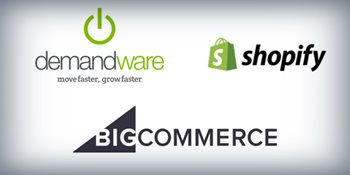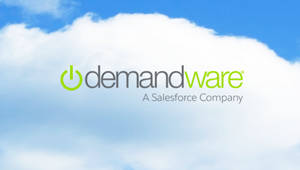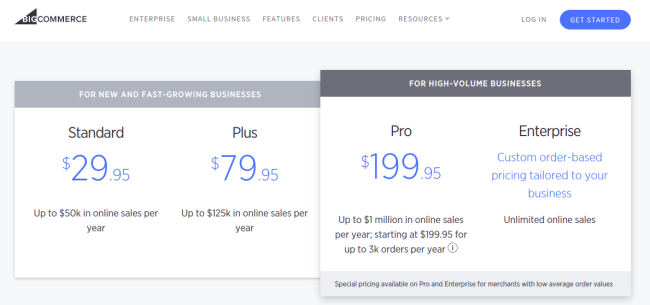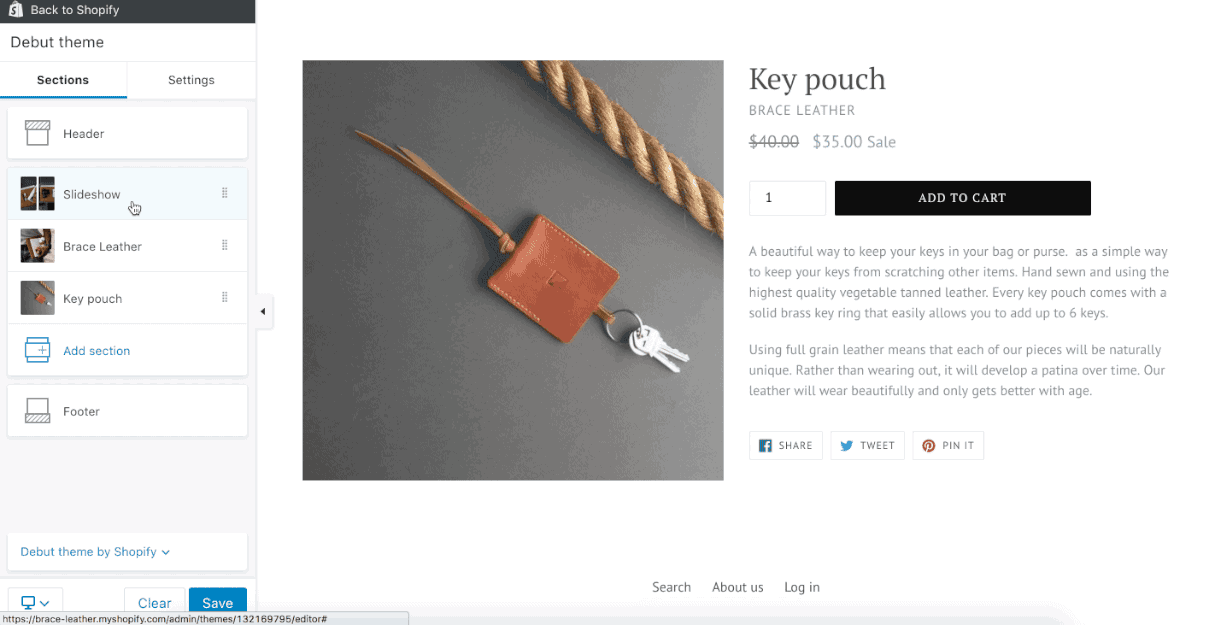CMSC Reviews Six Top Enterprise eCommerce Platforms - Part I
According to a recent report by Verizon Enterprise Solutions’ third annual Verizon Communications Inc. Retail Index, the average daily eCommerce traffic volume to U.S.-based retailers on Black Friday was up 9% year over year while peak e-commerce volumes were 39% higher than 2015 levels, indicating increased consumer engagement through digital platforms. No wonder why Forrester predicted that online retail sales are projected to surpass traditional sales for at least several years, and the research firm also stated that online retail sales are expected to reach $370 billion by 2017.
 These all are pieces of good news if you are ready to jump into the pool and dive into creating your online store, but as easy as it is to set up an online store today, it has become increasingly difficult to choose the right e-commerce platform to leverage. Therefore, it’s important to find out what’s required to open a successful online storefront and from there, you should shortlist the platforms that would meet your business’ needs. Again, it’s not an easy task so to help you navigate these daunting waters and narrow down your choices, I have shortlisted 6 e-commerce platforms that will enhance your ability to manage your online store and engage with customers. Part one of a two part series giving on a rundown of the key features, pros and cons, and pricing of Demandware, BigCommerce, Shopify, Hybris, Magento, and commercetools.
These all are pieces of good news if you are ready to jump into the pool and dive into creating your online store, but as easy as it is to set up an online store today, it has become increasingly difficult to choose the right e-commerce platform to leverage. Therefore, it’s important to find out what’s required to open a successful online storefront and from there, you should shortlist the platforms that would meet your business’ needs. Again, it’s not an easy task so to help you navigate these daunting waters and narrow down your choices, I have shortlisted 6 e-commerce platforms that will enhance your ability to manage your online store and engage with customers. Part one of a two part series giving on a rundown of the key features, pros and cons, and pricing of Demandware, BigCommerce, Shopify, Hybris, Magento, and commercetools.
Demandware
Launched in 2004, Demandware is a cloud-based e-commerce platform and uses a  subscription model that is based on revenue sharing. Demandware was acquired by Salesforce for $2.8 billion in cash which marked the largest deal in Salesforce M&A history. According to Demandware's annual report, as of December 31, 2015, they had 331 revenue generating e-commerce customers operating sites on Demandware Digital, up from 204 and 267 as of December 31, 2013 and 2014, respectively. Its customers include Adidas, Amercian Golf, Brooks, Browns, Burton, Butlers, Clarins Paris, ColeHaan, Columbia, Converse, Deckers, Hurley, Kate Spade, Labelux, Lacoste, Lush, Mothercare.
subscription model that is based on revenue sharing. Demandware was acquired by Salesforce for $2.8 billion in cash which marked the largest deal in Salesforce M&A history. According to Demandware's annual report, as of December 31, 2015, they had 331 revenue generating e-commerce customers operating sites on Demandware Digital, up from 204 and 267 as of December 31, 2013 and 2014, respectively. Its customers include Adidas, Amercian Golf, Brooks, Browns, Burton, Butlers, Clarins Paris, ColeHaan, Columbia, Converse, Deckers, Hurley, Kate Spade, Labelux, Lacoste, Lush, Mothercare.
If you are looking for a feature rich platform to build unique eCommerce storefronts, Demandware is one the best platforms in the market. However, if you just want to get a simple storefront up and running, this initiative could become overwhelming as there is also a learning curve to be able to tackle it successfully.
Key Features and Benefits
Shared Revenue Model: To me, the most interesting feature of the platform is its business model. Demandware’s subscription model is based on revenue sharing, meaning that each of Demandware’s clients pays a small percentage of their monthly sales towards their subscription. To put this into context, if Demandware doesn’t do a great job then there will be no income for both parties, so its like the company is your third-party business partner.
Customer service: Due to its business model explained above, the whole organization is dedicated to providing their clients the best quality service so they can grow into a brand business. To do so, Demandware has a global team of technical support and development experts that provide 24/7 support to customers and partners. Additionally, they have a resource center and blog that they use to keep the community up to date with information on varying topics.
Customization and Integration: Demandware is an omnichannel platform that offers out-of-the-box (OOTB) features for eCommerce with POS and order management into one solution. Due to its open architecture, the platform makes it easy to integrate the features that you can’t find in the Demandware system. The platform is customizable via server-side JavaScript, with a rich Demandware-specific API. The current version of the platform supports good patterns and practices, via CommonJS modules, while still making it possible to edit, save, and view your changes almost immediately on a development instance. Developers can quickly build custom applications and interface legacy programs with the Demandware platform. OOTB APIs for integration to 3rd-party applications like Social Media, payment gateways, and other critical applications also add to the low implementation effort level.
There are also third-party integrations available through the third-party LINK Marketplace. In consecutive releases, Demandware also incorporates Systems Integrators who actively implement the platform and develop industry-specific extensions and APIs. However, to do so, Demandware makes its partners go through a lengthy trial period before they can be considered major Demandware affiliates. LINK affiliates provide Demandware customers with the best possible support and design to make integration work.
SEO: Although there are still technical SEO issues on dynamic page handling, Demandware has a friendly and flexible SEO system as it offers advanced SEO and marketing tools such as customer segmentation and grouping capabilities.
Scalability: Since Demandware is a SaaS solution providing a solid infrastructure, the platform is very scalable and tuned for high performance, as long as users follow common sense architecture. The platform provides optimal speed even at peak traffic times. Additionally, in case the site crashes due to high traffic, built-in redundancies and disaster recovery solutions are available in the system.
Inventory: There are a few e-commerce platforms that have inventory optimization, and Demandware is one of them. It essentially means that you can create promotion rules that are based on customer behavior analysis and inventory on hand information so you can get a real-time update on your inventory, coordinated by some of the backend systems in the industry.
Product and Content Management: Demandware platform offers centralized product and content management. Due to its instrumental user interface, merchandisers can easily manage products across catalogs and site. They also have a full control over their product descriptions with master catalog structures. Additionally, developers can use their favorite web-editing suite to manage the online store.
Campaigns and Promotions: This feature supports a complex number of configurable conditions and business rules. With little development effort on their part, merchandisers set different kinds of targeted deals and content up and running. From there, they can manage the components through the Business Manager interface.
Drawbacks
-
Demandware was built for retail, and as a result is not ideally suited for complex B2B pricing and promotions use-cases.
-
There are some concerns about quality assurance with third-party vendors as some believe that many of the third-party extensions are clunky and quickly cobbled together, and surely require further investment of time. Also, it has been said that merchandisers are not empowered enough when it comes to their site’s functionality as the platform gives a lot of control to Demandware and its partners, so much so that merchandisers might have to make some changes to your website when one of Demandware’s affiliates upgrades their service.
-
Demandware is not a platform that you can build it and forget about it so some amount of maintenance over time to keep things up to date is mandatory.
-
Although the business model results in receiving a better customer support, some don’t like it as pricing is variable. At the end of the day, if your company does more sales, you end up paying more.
Pricing
Demandware merchants pay a standard licensing fee. In addition, Demandware takes a percentage of your sales. It has a reputation as the platform of the high-tier retailers.
BigCommerce
BigCommerce is a complete and feature-rich hosted e-commerce platform which is used by over 100,000  live online sites including Toyota, Payless, and Martha Stewart. Early this year, BigCommerce underwent a big rebranding project, and they didn’t only newly brand themselves but also added more integrations and a tranche of new features for the users.
live online sites including Toyota, Payless, and Martha Stewart. Early this year, BigCommerce underwent a big rebranding project, and they didn’t only newly brand themselves but also added more integrations and a tranche of new features for the users.
Features and Benefits
Essential e-commerce features like gift cards, reviews & ratings, as well as basic marketing tools are built-in into BigCommerce software. Besides already built-in e-commerce features, the platform offers a sheer volume of external apps. Many of those apps are free while others have a monthly fee. You do not have to purchase / use any of the apps, but they are there to use if needed.
BigCommerce provides a fully functional website, unlimited bandwidth & storage. Additionally, you can create an unlimited product and product options such as size, color, weight, etc.
SEO: Technical stuff like hosting, platform updates, and debugging are taken care of as it is a hosted platform, and their hosting servers are optimized for e-commerce, monitored 24/7, and guarantee a 99.99% uptime. Websites that load in under three seconds have a lot of advantages versus websites that take longer to load. On this note, BigCommerce provides a fast content delivery network which makes websites load fast and smooth. Their themes are all designed to load quickly as well. Speed is crucial for merchandisers in terms of both customer experience and search engine optimization. The platform also enables users to control the permalinks for their individual product pages and site content as well as title and Meta elements. Moreover, the native SEO features end there but there is an extensive app marketplace within BigCommerce where you may be able to find apps to help with your search optimization, including scoring your current efforts.
Design: The platform is designed as user-friendly and intuitive. Their free storefront editor enables users with no web designing skills to change basic design functions. However, if you need more complex design changes and you or your team is comfortable with HTML and CSS, then you can easily tweak things around to give your store a unique look.
Deployment: Some people may get overwhelmed by the comprehensive list of features and tools offered in the beginning, especially if it is their first time using an e-commerce platform. Therefore, as with everything else, you will need to invest a few hours in learning how everything works. Once you grasp the basics, though, it is all downhill from there.
Customer Service: With extensive guides, comprehensive setup wizard, auto-responder email functionality, video guides, and more, the platform offers a decent customer support. Furthermore, they offer you exclusive access to BigCommerce University where you can learn all about e-commerce by watching video tutorials on how to build your online store, attract customers, create buyers, and build proper customer loyalty programs. This is a great feature as every owner of the online store is not necessarily trained in the e-commerce space.
Security: Users’ online shop is Level 1 PCI compliant whereas the shopping cart includes an SSL certificate that uses industry standard 128-bit encryption technology (the same level of encryption used by large banks). All BigCommerce plans offer a shared SSL certificate for free. You can also purchase/transfer a dedicated SSL certificate that provides an additional layer of security. On top of that, users can create a backup file of their store orders, products, product images, and theme customizations.
Payment: Since the platform supports more than 60 payment gateways, you don’t need to send your customers to a platform like PayPal as you can determine to process payments through your website.
BigCommerce enables merchandisers to sell their products internationally and on popular marketplaces like Etsy, Rakuten, eBay, and Amazon.
Themes: Each free theme has anywhere from three to four different styles and BigCommerce offers seven free themes. It’s not all that hard to customize them or make them do what you want. Additionally, 80 premium themes, ranging from $145 to $235 are also available.
One of my favorite features BigCommerce offers is that users have the option to download their template files and work on them offline.
Abandoned cart: As you may know, on average, two out of three of your potential customers actually place products into the checkout page, and then forget to complete the checkout process? To tackle this issue, BigCommerce offers the abandoned cart saver which enables merchandisers to remind customers to purchase the products that they added to the shopping cart. It’s claimed that the abandoned cart saver feature recovers about 15% of lost sales on average. The abandoned cart saver is available for the Plus, Pro, and Enterprise plans.
Mobile commerce: Mobile shopping cart features are included for free. Their themes are responsive across devices, meaning that when a customer visits your e-commerce store from a mobile device, your store will automatically adjust and resize to the proper size that is best suited for that particular device. BigCommerce no longer offers a mobile app that allows merchandisers to manage your store from a mobile device. However, they can still receive new order notifications via email and text message.
Drawbacks
-
The pricing structure that I will explain in a bit, can be a deal breaker for a large organization that generates high revenue.
-
Users cannot accept recurring payments without having to use one of the recurring billing apps.
Pricing
In terms of pricing, BigCommerce has a monthly fee, and its plans vary from $29.95 for the Standard plan to $199.95 for the Pro plan. There is a 10% discount that is applied to all annual plans. In addition to those plans, BigCommerce offers an Enterprise solution that can be tailored based on your business needs but to explore that option, but contacting their sales department is necessary. You can also try out a free, 15-day trial before committing to anything. A credit card is not required for the free trial. With the exception of the Enterprise plan, the rest of the BigCommerce plans have a limitation on a number of sales volume you can process each year. The annual sales volume is $50,000 for the Standard plan, $125,000 for the Plus plan, and $1,000,000 for the Pro plan. It’s also worthy to note you only get up to 3,000 orders per year, and once you surpass that mark they start charging you $80 for every additional 1,000 orders. This limitation can compensate for not having to pay for transaction fees.

Shopify
Shopify was founded in 2006 by Tobias Lütke, Scott Lake and Daniel Weinand. Today, Shopify is a dominant platform in the market as it is currently powering over 325,000 online shops and has helped businesses process over $24 billion worth of sales. Companies like Google, Wikipedia, and Tesla use Shopify for their store. The key driving factors behind this success are ease of use and deploying of the platform, appealing storefront themes, and comprehensive e-commerce tools (with 1,500+ Apps in their App Store).
platform in the market as it is currently powering over 325,000 online shops and has helped businesses process over $24 billion worth of sales. Companies like Google, Wikipedia, and Tesla use Shopify for their store. The key driving factors behind this success are ease of use and deploying of the platform, appealing storefront themes, and comprehensive e-commerce tools (with 1,500+ Apps in their App Store).
Key Features and Benefits
Themes and design options: Shopify offers you over 100 premium e-commerce themes and a handful of free themes to help users’ online stores look clean and professional to build credibility and trust. Their premium themes range from $80 to $180. Considering the layout is a one-off investment, the pricing is reasonable in the long term. However, if you have a limited budget to begin with, you can always pick a free one, and upgrade to a premium theme as your business ramps up. On a side note, Shopify invites professional theme designers to create themes for Shopify. The themes which pass the quality check by Shopify take their place in the theme store.
Shopify App Store: Shopify has an App Store where users can choose from over 1,500 different Apps (free and paid) to plug into their online stores. From inventory management, customer service to accounting, fulfillment, and shipping, there are apps that provide additional functions for just about every task. Also, key third party apps are supported, including Xero, Freshbooks, Zendesk, and Aweber.
SEO: Shopify enables custom title tags, Meta descriptions, canonical tags to avoid duplication. Additionally, the platform automatically generates an XML sitemap for your online store, meaning that even those who don't have much technical knowledge can easily make their store Google friendly with Shopify.
Shopify Sections: Shopify Sections is a new feature that is close to a drag and drop builder in a sense. The visual editor offers a broad range of content sections that you can insert onto your homepage. You can add a section with the click of a button and arrange the order of your sections by dragging and dropping them in the sidebar.

Customer Service: Shopify customers are highly satisfied with its customer service as they can be reached at any time through phone support, online live chat or email. The company also provides four international phone numbers as well as extensive FAQ database.
Mobile commerce: Shopify offers free, built-in mobile e-commerce shopping cart features. The online store is automatically adjusted to the optimum size that suits the particular device used, so the consumers can experience the same quality when they are on the go. The platform also delivers a holistic mobile experience to users if they need to check the analytics, customer data, or manage their sales order on their mobile devices.
Security: Shopify also backs up the data automatically every day. Users’ online shop is Level 1 PCI compliant whereas the shopping cart includes an SSL certificate that uses industry standard 128-bit encryption technology (the same level of encryption used by large banks).
Drawbacks
-
When I was going through the reviews by users, I stumbled upon this comment and thought it’s worth it to mention: “For a company with many products (growing beyond 5+ products), Shopify's pricing makes it completely prohibitive for use. The pricing model is not built out to support this and it's just not practical, especially for any startup company that is working with limited funds.”
-
Customizing an online store powered by Shopify is not an easy task, although you know or have a staff that knows the basic codes such as HTML and CSS. Because Shopify also uses their own coding language called “Liquid”, to get this task done, you need to hire a Shopify Expert who knows Liquid. So it means an additional cost. Therefore, website customization may take a backseat during the initial period until your website picks up speed.
-
The platform doesn’t automatically display product images using the same aspect ratio. This means an extra workload as you need to crop/resize all your images in advance of uploading them to Shopify.
-
Shopify Payments only allows you to sell from certain countries – US, Canada, Australia or the UK. If you want to sell from another country you will need to use a payment gateway. Using a third-party payment gateway requires a bit of configuration – you’ll need to set up a ‘merchant account’ with a payment gateway provider. If you use a payment gateway, Shopify will apply a transaction fee and so will the payment gateway provider.
Pricing
You can try out a free, 14-day trial before committing to anything.
-
Lite – $9 per month for credit cards rates of 2.9% + 30¢, a Shopify buy button (so your site is technically not a real online store,) Facebook selling, POS integration, fraud analysis, manual order creation and shipping codes. One staff account is provided.
-
Basic – $29 per month for everything in the previous plan, credit card rates of 2.9% + 30¢, an actual online store, 24/7 support, fraud analysis, manual order creation, discount codes, a website and blog, and a free SSL certificate. Two staff accounts are provided.
-
Pro – $79 per month for everything in the previous plan, credit card rates of 2.6% + 30¢, an actual online store, gift cards, professional reports and abandoned cart recovery. Five staff accounts are provided.
-
Advanced – $299 per month for everything in the previous plan, credit card rates of 2.4% + 30¢, an actual online store, advanced report builder and real-time carrier shipping. 15 staff accounts are provided.
Also, check out the second part where we review the key features, pros and cons, and pricing of commercetools, Hybris, and Magento.

Venus Tamturk
Venus is the Media Reporter for CMS-Connected, with one of her tasks to write thorough articles by creating the most up-to-date and engaging content using B2B digital marketing. She enjoys increasing brand equity and conversion through the strategic use of social media channels and integrated media marketing plans.